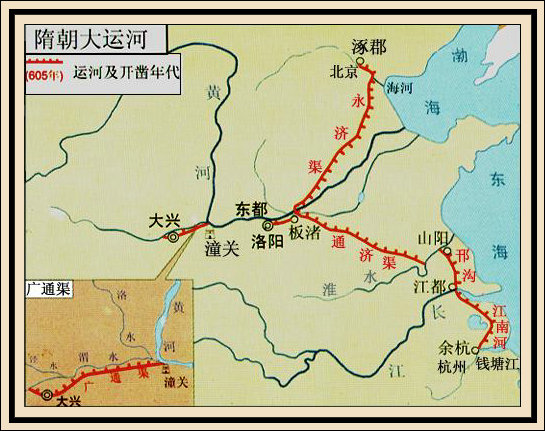大运河的开凿
The Grand Canal (大运河)of China, also known as the Beijing-Hangzhou Grand Canal (京杭大运河)is the largest ancient canal or artificial river in the world.
中国的大运河也就是京杭大运河是世界上最大的古代运河和人造河流。
The oldest parts of the canal can be traced back to 5th century B. C.
其中最古老的段落可以追溯到公元前5世纪。
In the year of 604, Emperor Yang Jian (杨坚)of Sui Dynasty (隋朝) left Chang’an, and made his rounds in Luoyang.
604年,隋炀帝杨坚离开长安,在洛阳巡视。
In 605, the emperor gave an order to build two projects: transferring the capital from Chang’an to Luoyang and excavating the Grand Canal linking Beijing and Hangzhou.
605年,隋炀帝下旨建造两项工程——将都城从长安迁至洛阳、开凿联通北京和杭州的大运河。
It took over six years to build the Grand Canal linking all the canals along it and connecting Haihe (海河),Yellow River (黄河), Huaihe (淮河),Yangtze (长江) and Qiantangjiong rivers (钱塘江).
建造大运河的工程花了6年时间将其沿线的各个河道串联起来并连接了海河、黄河、淮河、长江和钱塘江。
The Grand Canal starts north in Beijing and ends south in Hangzhou (杭州)with a total length of l794 kilometers.
大运河北起北京南至杭州,全程长1794公里。

As the earliest and longest man-made canal in the world, the canal is the economic and cultural communication bridge of the north and south, which was first built in the 5th century BC and was substantially extended twice during the Sui and Yuan dynasties.
作为世界上最早和最长的人工运河,京杭大运河是连接中国南北的经济与文化交流之桥,它首建于公元前5世纪,在隋朝和元朝期间延伸建设了两次。
In nowadays, the speedy urbanization process and the enormous landscape change projects such as the water diverting projects from the south to the north, offer great opportunities to the sustainable development of our country.
今天,快速的城市化进程和巨大的地形改变工程例如“南水北调”工程为我国的稳定发展创造了巨大的机遇。













